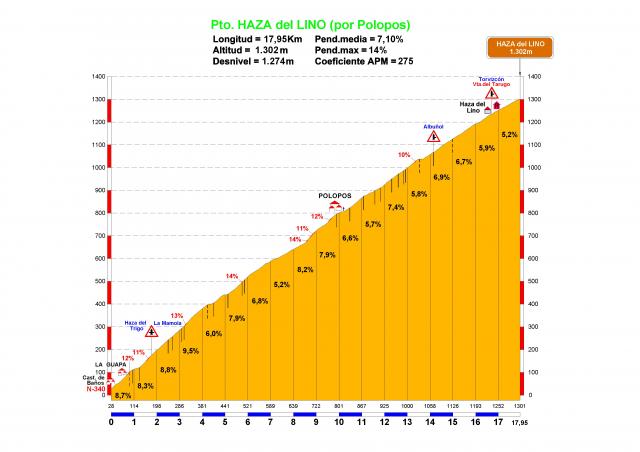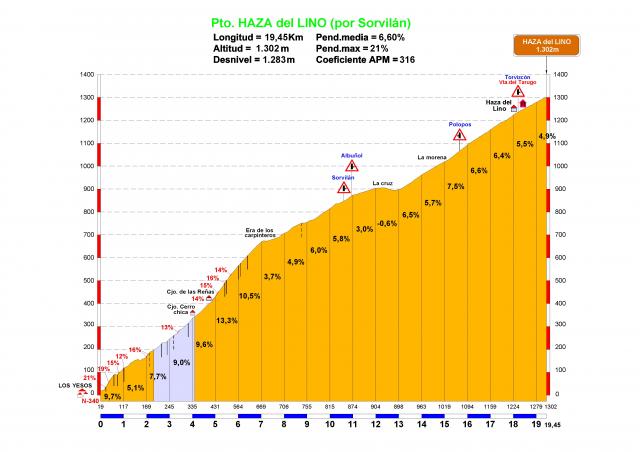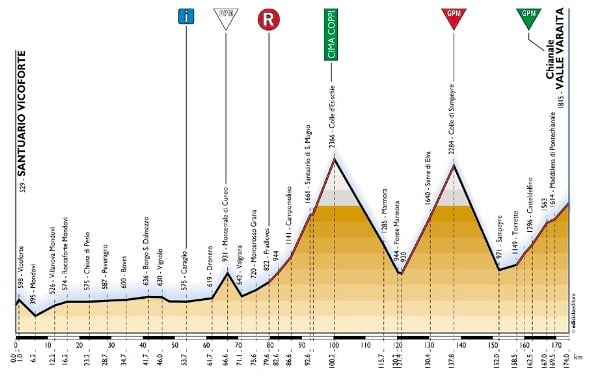2021 Giro Route Rumours
Page 5 - Get up to date with the latest news, scores & standings from the Cycling News Community.
You are using an out of date browser. It may not display this or other websites correctly.
You should upgrade or use an alternative browser.
You should upgrade or use an alternative browser.
- Apr 15, 2016
- 4,229
- 659
- 17,680
This would be very good as well:Hardest mountain pass in mainland Spain IMHO is Collado de las Sabinas in Sierra Nevada through Güejar Sierra+Hazallanas+Sabinas, then descending through the main road to Granada (or up again through Sabinas and finishing as high as 2843m, which would be the highest GT point ever ridden). All three parts have been used in the Vuelta before, but never together.

Apart from Ancares (four sides, two of them legit HC), my personal wish would be to see Haza de Lino, south of Granada. Five sides, the two hardest being:



I would love to see something like this in Vuelta ( taken from one of my Vueltas in the Race Design Thread ) : https://www.cronoescalada.com/index.php/tracks/viewVuelta/657300/317038
- Mar 24, 2011
- 10,527
- 1,927
- 25,680
it's being reconditioned, I think.Anyway I take it from reading this thread that the Fauniera road has been reconditioned?
- Jun 16, 2015
- 1,948
- 525
- 12,080
My dream is a stage starting in Cuneo, then Pradleves, Castelmagno, Colle d'Esischie (basically Fauniera, but you turn right 1 km before the summit), descent to Ponte Marmora, Colle di Sampeyre, descent to Sampeyre, summit finish at the Agnello. About 5100 meters of elevation gain in 130 km

That's stage 18 of 2003. They finished stage 17 with 137 riders, but after this behemoth of a stage there were only 97 riders left. Six riders did not finish and 35 riders including Alessandro Petacchi in maglia ciclamino after six stage wins, missed the time cut.

That's stage 18 of 2003. They finished stage 17 with 137 riders, but after this behemoth of a stage there were only 97 riders left. Six riders did not finish and 35 riders including Alessandro Petacchi in maglia ciclamino after six stage wins, missed the time cut.
I didn't knew about this stage because in 2003 I was only 10 years old, I started to follow pro cycling in 2005 with Ivan Basso at the Tour.
Anyway, that stage must have been great. My suggestion in the previous post was to keep going after Chianale climbing the famous last 10 km of the Agnello.
Those 3 climbs one after the other are out of this world, when the easiest climb (Colle di Sampeyre) is 17.8 km at 7.6%, then you have a problem
- Jun 7, 2010
- 19,196
- 3,092
- 28,180
That's stage 18 of 2003. They finished stage 17 with 137 riders, but after this behemoth of a stage there were only 97 riders left. Six riders did not finish and 35 riders including Alessandro Petacchi in maglia ciclamino after six stage wins, missed the time cut.
Yeah, but the weather also turned *** that day
to think it was only 17 years ago when going uphill and downhill through snow on the road was not worthy of making a fuss
better quality vid
Last edited:
- Feb 18, 2015
- 13,828
- 9,830
- 28,180
I mean they have done the Agnello in the Tour and I don't know if there even is a harder french climb? Almost all big, French passes in the pyrenees are overused already (Port de Larrau probably being the hardest of the not so overused ones) the same counts for the passes in the more northern part of the French Alps, and while there are a lot of pretty unknown HC calibre climbs south of Barcelonnette none of them are steep enough to be considered monsters. To be fair, stage 20 of the 2016 Giro was probably about as hard as it can get in that part of France.Now I'm actually curious what the hardest climb that's actually rumored generally for the Tour?
- Jun 7, 2010
- 19,196
- 3,092
- 28,180
Okay, thank you.
Agreed on a stage around Cortina. Save for the two combos of Mortirolo-Aprica and Finestre-Sestriere
Just realized that neither of these combos have been used since 2015, although both climbs have been used after that with other stage design. Based on the rumours they will probably not be used next year either, but it would be about damned time they where included again. You can't really go wrong with one of those two stages.
For next years tour? Mont Ventoux.Now I'm actually curious what the hardest climb that's actually rumored generally for the Tour?
- Feb 20, 2012
- 54,069
- 44,426
- 28,180
Nah I mean overall. What's that climb that does get credible rumors but hasn't happened yet/in a very long timeFor next years tour? Mont Ventoux.
- Apr 10, 2019
- 12,096
- 16,041
- 23,180
Maybe Granon? Otherwise probably Port de Larrau, but I've never heard a lot of rumours about that one. I guess Col du Jandri rumours are usually not that credible.Nah I mean overall. What's that climb that does get credible rumors but hasn't happened yet/in a very long time
The last few years climbs like Mont du Chat, Grand Colombier, Mont Ventoux and new climbs like Loze and Portet have all been used. All these are probably worth mentioning in a discussion about the toughest climb in France. The only climb I can think of that is equally hard or even harder than these, is some crazy rumour like Parpallion or even MTF at Pic du Midi. But that's probably not credible rumours.......Nah I mean overall. What's that climb that does get credible rumors but hasn't happened yet/in a very long time
Edit: Pierre Saint Martin via Issarbe is probably the toughest French climb which still haven't been used, but likely could be ridden. But I'm not sure if I've ever seen it rumoured.
- Apr 10, 2019
- 12,096
- 16,041
- 23,180
In 1995 they had this stage, but an avalanche hit a car of the race organizers on the day of the race and blocked the road on the Agnello, so they had to stop in Pontechianale.I didn't knew about this stage because in 2003 I was only 10 years old, I started to follow pro cycling in 2005 with Ivan Basso at the Tour.
Anyway, that stage must have been great. My suggestion in the previous post was to keep going after Chianale climbing the famous last 10 km of the Agnello.
Those 3 climbs one after the other are out of this world, when the easiest climb (Colle di Sampeyre) is 17.8 km at 7.6%, then you have a problem

Overall 1995 was a really hard Giro, one of the hardest in the modern era.
In 1995 they had this stage, but an avalanche hit a car of the race organizers on the day of the race and blocked the road on the Agnello, so they had to stop in Pontechianale.

Overall 1995 was a really hard Giro, one of the hardest in the modern era.
I remember I heard something about an avalanche on the Agnello in the 90s during the Giro...didn't knew that this was the profile of the stage. Great stage, however the Fauniera before the Sampeyre is way harder than the Izoard after the Agnello.
- Jun 16, 2015
- 1,948
- 525
- 12,080
- Apr 15, 2016
- 4,229
- 659
- 17,680
- Feb 18, 2015
- 13,828
- 9,830
- 28,180
The Mortirolo stage last year was pretty similar to Mortirolo-Aprica so that can rest for a bit as far as I'm concernedJust realized that neither of these combos have been used since 2015, although both climbs have been used after that with other stage design. Based on the rumours they will probably not be used next year either, but it would be about damned time they where included again. You can't really go wrong with one of those two stages.
John-Lee AugustynI would love to see Moutiere-Bonette at the Tour, or just Bonette in general. The last time Tour used Bonette was in 2008.
Concerning the "Fausto Coppi" stage (I mean the one with the Fauniera, basically the same route of the Granfondo Fausto Coppi) I have some doubt about the descent from Valmala to Lemma. There is a segment of the descent (few km) with a very narrow road.
For this reason I suppose that they could decide to use the Sampeyre instead of Valmala, because the road descending to Stroppo is a bit wider. I think that Vegni is going to discuss about the Sampeyre with the mayors of the little villages of the Valle Varaita since they were supposed to have the Giro with the Agnello stage this year. The Sampeyre could be a good way to compensate (even if only partially) for the loss of the Agnello in 2020.
The Sampeyre was also in the original route of the Granfondo Fausto Coppi, then they switched to Valmala probably to make the race a bit easier (still 4700 m of elevation gain) and because of poor road surface for the descent. It's been 10 years since the last time I rode the Sampeyre from Stroppo so I am not informed about the condition of the road...however it can't be too bad because it is the only road to reach the Sampeyre from Valle Maira since the amazing road of the "Vallone di Elva" has been closed for years because of landslides.
For this reason I suppose that they could decide to use the Sampeyre instead of Valmala, because the road descending to Stroppo is a bit wider. I think that Vegni is going to discuss about the Sampeyre with the mayors of the little villages of the Valle Varaita since they were supposed to have the Giro with the Agnello stage this year. The Sampeyre could be a good way to compensate (even if only partially) for the loss of the Agnello in 2020.
The Sampeyre was also in the original route of the Granfondo Fausto Coppi, then they switched to Valmala probably to make the race a bit easier (still 4700 m of elevation gain) and because of poor road surface for the descent. It's been 10 years since the last time I rode the Sampeyre from Stroppo so I am not informed about the condition of the road...however it can't be too bad because it is the only road to reach the Sampeyre from Valle Maira since the amazing road of the "Vallone di Elva" has been closed for years because of landslides.
Last edited:
- Feb 20, 2012
- 54,069
- 44,426
- 28,180
I found that one recently, is it raceable? I'm a pretty big believer in those 20km 2300m+ climbs in general. Even if not Agnello or Fauniera steep they're clearly still a platform for big moves.I would love to see Moutiere-Bonette at the Tour, or just Bonette in general. The last time Tour used Bonette was in 2008.
- Feb 20, 2012
- 54,069
- 44,426
- 28,180
Sampeyre means taking Fauniera from the north side right?Concerning the "Fausto Coppi" stage (I mean the one with the Fauniera, basically the same route of the Granfondo Fausto Coppi) I have some doubt about the descent from Valmala to Lemma. There is a segment of the descent (few km) with a very narrow road.
For this reason I suppose that they could decide to use the Sampeyre instead of Valmala, because the road descending to Stroppo is a bit wider. I think that Vegni is going to discuss about the Sampeyre with the mayors of the little villages of the Valle Varaita since they were supposed to have the Giro with the Agnello stage this year. The Sampeyre could be a good way to compensate (even if only partially) for the loss of the Agnello in 2020.
The Sampeyre was also in the original route of the Granfondo Fausto Coppi, then they switched to Valmala probably to make the race a bit easier (still 4700 m of elevation gain) and because of poor road surface for the descent. It's been 10 years since the last time I rode the Sampeyre from Stroppo so I am not informed about the condition of the road...however it can't be too bad because it is the only road to reach the Sampeyre from Valle Maira since the amazing road of the "Vallone di Elva" has been closed for years because of landslides.
Sampeyre means taking Fauniera from the north side right?
No, you simply climb the Sampeyre from Sampeyre (Valle Varaita, north side) and descend to Bassura di Stroppo. Then you can decide what to do:
- Climb Fauniera from Ponte Marmora, northern side....but the road is very narrow and in poor conditions.
- Keep going down on the false flat (23 km) until Dronero, climb Montemale (possibly La Piatta Soprana), go down to Valgrana, climb the Fauniera from the side of Castelmagno.
TRENDING THREADS
-
 Teams & Riders The Remco Evenepoel is the next Eddy Merckx thread
Teams & Riders The Remco Evenepoel is the next Eddy Merckx thread- Started by DNP-Old
- Replies: 36K
-
 Teams & Riders Tadej Pogačar discussion thread
Teams & Riders Tadej Pogačar discussion thread- Started by Lequack
- Replies: 41K
-
Teams & Riders The Great Big Cycling Transfers, Extensions, and Rumours Thread
- Started by RedheadDane
- Replies: 13K
-
-
-
Teams & Riders Everybody needs a little bit of Roglstomp in their lives
- Started by johnymax
- Replies: 23K
-
 Teams & Riders Jonas Vingegaard thread: Love in Iberia
Teams & Riders Jonas Vingegaard thread: Love in Iberia- Started by Samu Cuenca
- Replies: 10K

Cyclingnews is part of Future plc, an international media group and leading digital publisher. Visit our corporate site.
© Future Publishing Limited Quay House, The Ambury, Bath BA1 1UA. All rights reserved. England and Wales company registration number 2008885.

